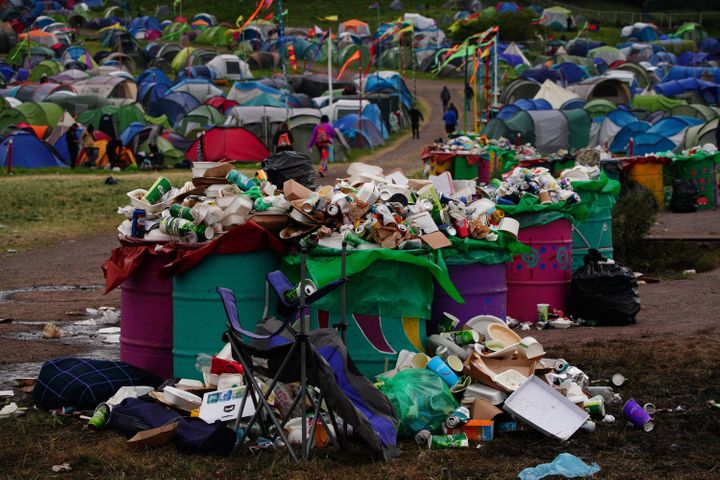
Today is Earth Day, an annual day to “broaden, educate and activate the environmental movement worldwide”, according to organisers.
Caring about the planet sometimes feel like fighting against the tide. Why, for example, am I suffering through the sensory hell of soggy paper straws while super-wealthy people are causing unfathomable harm through the transport they use?
Advertisement
One Oxfam report looked at 23 superyachts owned by billionaires and found they travelled an average of 12,465 nautical miles a year. The charity explained “this is equivalent to each superyacht crossing the Atlantic almost four times”.
It added the average annual carbon footprint of each of these yachts is estimated to be 5,672 tonnes and “it would take the average person 860 years to emit the same pollution”.
I mean. Doesn’t it just make you want to scream?
This frustration doesn’t leave us without responsibility, though
Environmental charity Friends of the Earth said making planet-friendly and ethical choices when it comes to how and what we consume is “more important than ever given the devastating impacts consumption, and particularly overconsumption, can have on our climate, ecosystems, habitats and communities”.
Advertisement
“Governments and companies around the world need to do much more to prevent environmental and human rights violations in global supply chains,” the charity said.
“But we as individuals can also make a difference through our purchasing habits and lifestyle choices.”
Over the past 10 years, this is something I have worked hard to do – and as my budget is often quite small, I’ve learned how to do it in a way that doesn’t cost too much, either.
Advertisement
8 changes I’ve made for a more sustainable lifestyle
Clothes swaps
According to Earth.Org, 92 million tonnes of textiles waste is produced every year: “To put things in perspective, this means that the equivalent of a rubbish truck full of clothes ends up on landfill sites every second.
“If the trend continues, the number of fast fashion waste is expected to soar up to 134 million tonnes a year by the end of the decade.”
Something my friends and I do together to tackle this is swap clothes.
When we’re tired of an item of clothing, or don’t send it back in time for a refund, we swap with one another. Some of my wardrobe staples are from my friends’ wardrobes (and vice versa).
Advertisement
Secondhand shopping
The BBC reported that 67% of millennials buy preloved clothes, and I’m one of them. Whether I’m looking for something to wear to a wedding or even replacing a long-lost jumper, the first thing I do is open up Vinted to find some bargains.
I also use Vinted and Ebay for buying homeware, records and notebooks.
I’m also a seller and have made hundreds of pounds from the clothes I’ve sold.
Sewing
I have a sewing machine that was a gift from my partner – but to be honest, when it comes to mending clothes, I find hand-sewing much simpler.
I have recovered and reworked so many old pieces of clothing using simple sewing techniques. There’s something really special about knowing you’ve given a pair of trousers a second life with just a little thread and fabric.
Advertisement
Reusing old towels
I have one towel that I left home with nearly 20 years ago that is only now showing pretty significant signs of wear. Once towels hit this stage, instead of throwing them out, I cut them into squares, clean them and then use them as my cloths for cleaning and dusting the home.
It’s not very ‘aesthetic’ but then again, neither am I.
Reducing meat intake
I am not a vegan or vegetarian for health reasons, but I do try to reduce how much meat I eat and red meat is only eaten once every few months.
Additionally, a 2023 study found that even individuals following low meat diets contributed to a reduction in environmental impact by approximately 30% across multiple measures compared to those on high meat diets.
Advertisement
It’s been easier than I thought it would be thanks to the versatility of dishes like curries, and I don’t even miss having meat more often.
Challenging my buying choices
Dare I say it, I think this has been the most impactful change as it’s now something I do every single time I buy something and, in fact, I recently returned from a holiday with no souvenirs other than branded paper napkins from a cafe.
Whenever I want to buy something, I ask myself if I really need it, do I have anything similar that would suffice and, finally, where do I see this item existing in my home in a year’s time?
Advertisement
It has meant that I’ve missed out on some VERY cute homeware but I know myself well enough to know that the fleeting dopamine rush of buying something new is usually the only benefit of splurging.
Washing clothes at 30°C
Strangely, this was one of the hardest ones for me. I love the feel of roasting hot clothes and towels coming out of the washing machine and have long been a laundry purist.
However, changing to this temperature has made my clothes last longer and definitely lowered my carbon footprint.
Advertisement
According to consumer experts Which?, washing at 30°C also uses 38% less energy than washing at 40°C. So I’m also reducing my bills.






 (@lauramarrisx)
(@lauramarrisx)  (@TJF_x)
(@TJF_x) 








